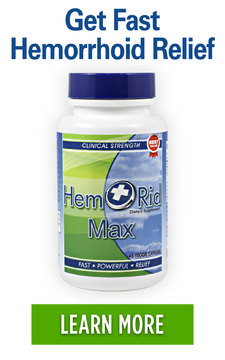Mild Hemorrhoids Pictures, Symptoms, Treatment and Help
Posted on 15 November 2018 by Maryanne Johnson
Share this post
Hemorrhoids are in the running for the most widely experienced condition, managing to be the third most common gastrointestinal diagnosis, chalking up to nearly 4 million office visits per year. You might not realize it, but about half of adults (prevalent most in ages 45-60) develop hemorrhoids and experience their painful symptoms.
Hemorrhoids are often kept quiet by those inflicted with this anorectal disease. Deemed an embarrassing topic, many sufferers only seek medical advice when symptoms worsen. For mild hemorrhoids, people are more likely to deal with symptoms on their own instead of visiting their doctor for assistance or diagnosis.
Still, this can present some troublesome effects. Even in mild hemorrhoid cases, rectal bleeding can occur, and without medical advice, this symptom can be neglected or written off as merely a residue effect of hemorrhoids.
Although it is rare, rectal bleeding could mean a more pressing gastrointestinal issue, like colon cancer, and despite these slim statistics, it should be taken seriously. Mild hemorrhoids can cause rectal bleeding, and your physician can determine if further examinations or testing is needed.
You might think you have mild hemorrhoids and wonder if the fact that they are reoccurring is normal. Flare-ups of mild hemorrhoids are frustrating and disappointing, just when you think you’ve got the condition under control, hemorrhoid symptoms rear their ugly head once again.
Here, we’ll go over everything you need to know about your mild hemorrhoids. There are some things you can be doing to stop flare-ups, and there are also risk factors you can try to avoid. Knowing more about this anorectal condition can help you keep it under control.
What Are Mild Hemorrhoids?
Mild hemorrhoids can include mild external hemorrhoids or mild internal hemorrhoids. Let’s break these two types down.
Mild hemorrhoids are the reaction your body gives in response to sudden inflammation of the lower rectal veins. Your rectal veins can be subjected to something constricting the blood flow.
There are common risk factors of straining and stress on the network of veins, arteries, and blood vessels, which we will delve into later, but in essence, your lower rectum is more sensitive than you might think.
These rectal veins can become inflamed in two distinct locations in the lower rectal region, leading to the development of either external or internal hemorrhoids. A downside with hemorrhoids, even with mild hemorrhoids, is that you can have these two types of hemorrhoids occur together, at the same time.
Mild hemorrhoids can cause irritating and painful symptoms, but this is more the case with mild external hemorrhoids, where the nerve endings are more sensitive to pain. The veins that traffic the skin beneath and surrounding the anus become inflamed, forming painful, sore lumps because of blood flow restriction and inflammation.
External hemorrhoids can become enlarged or even thrombosed. For a mild case of external hemorrhoids, you probably won’t experience these issues, although a small blood clot does have the potential to form.
A blood clot in an external hemorrhoid is what is termed as a thrombosed hemorrhoid. If you have mild external hemorrhoids and they become thrombosed, it’s nothing to worry about. The blood clot can go away on its own, or your doctor can lance it open and drain it.
Internal hemorrhoids are easier to deal with because they do not produce nearly as painful symptoms as external hemorrhoids. Internal hemorrhoids are rated based on their prolapse, but before you panic at the term "prolapsed hemorrhoid," a protrusion of an internal hemorrhoid doesn't happen in mild cases.
Grade I internal hemorrhoids are mild and moving up to Grade IV, the most serious Grade, hemorrhoids become prolapsed to a point where surgery is needed to resolve the issue. However, people don't start with Grade IV hemorrhoids.
If you want to know if you have mild hemorrhoids, the best thing you can do is to first read up on the symptoms of both types, and then make an appointment with your doctor for a proper diagnosis.
Mild Hemorrhoid Pictures
Many people wonder if they have mild hemorrhoids and what exactly they should be looking for if they do have this condition. Mild hemorrhoids don’t typically vary in their looks, and the most apparent symptoms you will notice are lumps that cluster around the anus.
The lumps brought on by external hemorrhoids look flesh-colored or can have a slightly darker pigmentation than the surrounding skin. These are masses known as mild external hemorrhoids, and yes, they do hurt quite a bit!
The anal area may be swollen and itchy, with a burning sensation. The lumps themselves differ in size—you could have one or several. If a blood clot forms inside one of these mild external hemorrhoids, the color can change to blue or purple.
Mild internal hemorrhoids are neither seen nor felt. Although in more progressive cases, a sufferer can experience a prolapse where the hemorrhoidal column protrudes through the rectum, this situation would not necessarily be defined as mild internal hemorrhoids.
With mild internal hemorrhoids, there can be anal discharge, fecal seepage, or swelling around the anus in general. These are all things to look out for because mild internal hemorrhoids do not often produce noticeable symptoms. Rectal bleeding is the most apparent symptom of mild internal hemorrhoids.
What Are Mild Hemorrhoid Symptoms?
Many sufferers often complain of itching, a burning feeling, and pain when it comes to having mild hemorrhoids. People with mild hemorrhoids have difficulty using the bathroom as they usually would, which also makes sitting down a painful and challenging task.
People with mild hemorrhoids will want to avoid engaging in straining or putting themselves through rigorous activities, like specific exercises. The friction of moving around can worsen the tender and sensitive lumps near the anus.
For mild external hemorrhoids, you will likely be subject to these symptoms:
- Painful, aching lumps around the anus
- Rectal and anal burning
- Pruritus (anal itching)
- A small blood clot (thrombosed hemorrhoid)
For mild internal hemorrhoids, you could experience these symptoms:
- Anal itching
- Rectal burning
- Anal discharge
- Rectal bleeding
Mild hemorrhoids go away in a few days, even if you do not treat them with any at-home remedies. The inflammation of the rectal veins eventually subsides, and the hemorrhoids respond by slowly shrinking away.
Top Mild Hemorrhoid Causes
Certain risk factors cause hemorrhoids. Some risk factors can be avoided or prevented, but others are out of our control.
Top mild hemorrhoid causes include:
- Age (people age 45 and older)
- Pregnancy and labor
- Constipation and straining
- Heavy lifting
- Sitting or standing for extended periods of time
Research has suggested that age plays a big role in hemorrhoids, and the theory behind this is that as our bodies age, the supportive tissues weaken, causing inflammation and the development of hemorrhoids. This strong hypothesis can account for so many adults age 45 and older experiencing mild to severe hemorrhoids.
Pregnancy and labor, as you can imagine, puts an enormous amount of stress and pressure on the rectal area, thus leading to the inevitable development of hemorrhoids.
Of course, with pregnancy, labor, and age, there isn’t much we can do in sidestepping these risk factors for hemorrhoids, but we can try to eat better to avoid constipation and straining on the toilet. We can also make sure we are moving around and not remaining sitting or standing for too long.
Best Mild Hemorrhoid Treatment Option
Mild hemorrhoids can be treated with several at-home solutions. With hemorrhoids, you can even try a few treatments in the comfort of your own home to discover which ones work best for you.
You can try these treatment options for mild hemorrhoids:
- A warm sitz bath
- Topical creams for mild hemorrhoids
- Wipes to clean and soothe the anal area
- An ice pack
- Oral painkillers
These treatment options relieve symptoms of mild hemorrhoids almost immediately.
Conclusion
Anything you can do to prevent straining and constipation will help you stop mild hemorrhoid flare-ups.
Hemorrhoid supplements, fiber supplements, laxatives, or stool softeners are all among the best mild hemorrhoid treatments, and instead of treating symptoms of mild hemorrhoids, these methods act more as a preventative measure.




0 comments